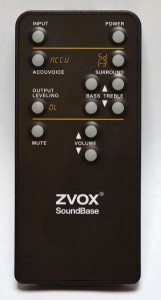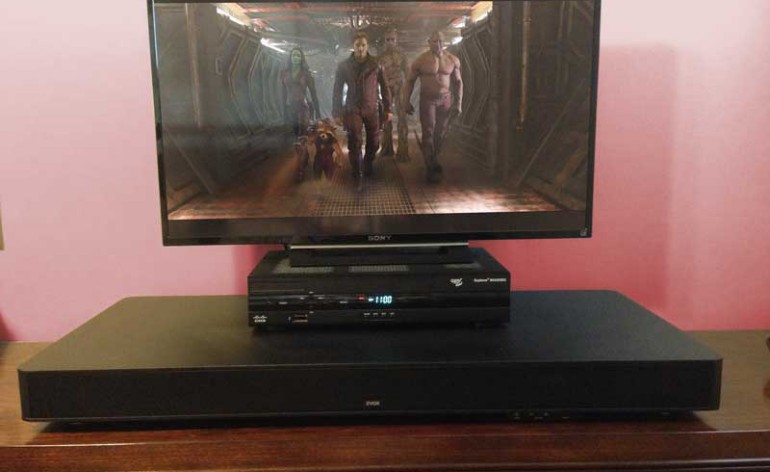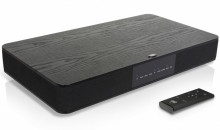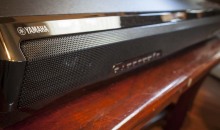ZVOX Soundbase 670 Speaker Hands-on Review
Overall, I really enjoy the ZVOX Soundbase 670. As a self-professed theater audio snob, I have to say I've learned something: I don't have to have 7.2 surround or nothing at all.
Buy the Zvox SoundBase 670
Buy It NowI’m a home theater audio snob. There. I’ve said it. I see this trait as a blessing and a curse. On one hand, I’m not an early adopter to all-in ones or HTIB (home theater in a box) solutions. On the other hand, I have a good appreciation of what sounds good from a reference standpoint. My home theater is a 7.2 surround configuration, meaning 7 speakers around the room and 2 subwoofers. I love my home theater, but I can’t really justify having this system wherever I have a TV in the house. That’s where a ZVOX Soundbase 670 comes in.
My gut reaction to a unit like the ZVOX Soundbase 670 is that it would be great in a temporary space, like an apartment living room or dorm room. I recently, however, had a client who had a sound bar in their bedroom. Sounds like a good idea in retrospect, but I simply never thought to use one there. My wife and I watch a lot of TV at night in our comfy master bedroom, but the TV speakers lack clarity and range. That said, I found the perfect spot for my review. After all, a TV speaker base system offers all of the benefits of a space-saving soundbar, but with even greater cabinet volume and less interference with the room aesthetics.
Features & Favorites

The remote is fully functional and “flimsy”, but it will wind up in a drawer once you program your main remote.
The ZVOX Soundbase 670 is the second largest model in ZVOX’s model lineup with a total of 6 models (in fact, they just announced two more at the 2015 CES Show). The top three models are referred to as “Platinum” on the website and have Bluetooth technology, Dolby Digital Processing, and “theater quality bass output”. Selecting the model which is right for you will be based primarily on Bluetooth requirements and room size. For my application, the 670 is technically oversized for my master bedroom, but there are other sizes available…plus I love the extra bass it affords. The Bluetooth feature was a big selling point for me. I already own a small 5×7″ portable speaker with Bluetooth connectivity, so I was very pleased—if not expecting—to see a speaker of the ZVOX Soundbase 670 caliber to have it as standard equipment.
In addition to Bluetooth are common connections including two rear optical and one coaxial digital inputs, an analogue stereo input, and a front 3.5mm stereo input. Outputs include a subwoofer RCA and 3.5mm stereo output. A handy remote is also included. Some reviews have bashed the remote as feeling cheap. In my opinion, the remote is highly functional and practical. Eventually, however, I just programmed my primary universal remote and put the ZVOX remote in my nightstand.
ZVOX Soundbase 670 Setup and Configuration
Unpacking the ZVOX Soundbase 670 speaker was a cinch. Once out of the box, it was pretty obvious that the ZVOX Soundbase 670 was designed for plug and play. Making connections on my set-up was as easy as possible. I merely needed to attach the provided optical cable to the TV output and the ZVOX Soundbase 670 optical input and connect the power cord. Beyond that, I had to disable the TV speakers through its own menu followed immediately with play time. The total time from unpacking to finishing the cable connections and final placement was under 30 minutes. It takes longer to heat a frozen family dinner in an oven!
I did whip through the simple instructions, but the operation of the remote seemed fairly intuitive, which was validated once I powered everything up. Input settings are clearly shown via a hidden LED display. This display is unnoticeable when it is off. Selecting the input is determined by the input used on the rear of the speaker. Each input is numbered, and there are 5 total input options including Bluetooth connectivity.
Bluetooth Pairing
Before I review the sound quality, I’ll talk about the Bluetooth setting and connection. Setting up the Bluetooth on the Soundbase 670 is similar to any other Bluetooth device pairing. Select the Bluetooth option on the Soundbase input control, and then look for the corresponding device on your Bluetooth searching feature on your phone, tablet, etc. Connection is quick, and the reliable range was within about 20 feet in my space. I loved the ability to stream music at-will from my Spotify streaming music account to the ZVOX Soundbase.
Sound Quality and Listening Tests
Overall sound quality on the ZVOX Soundbase 670 soundbar was impressive. The highest scoring aspect was the richness of the sound. Lows were decent, and highs were clear. With the TV as the source, I did struggle to hear vocal dialogue at lower volume levels, however. After some adjustment via the included remote control, vocals were more discernible, but the ZVOX Soundbase 670 really wants to be played at a louder level in order to better balance the output frequencies. Part of this may have been due to the acoustics and size of my room combined with the TV source signal. Music performance was enjoyable using an iPhone connected via Bluetooth. I also played some cuts from Pandora and really enjoyed how the Soundbase filled the entire room. The PhaseCue II virtual surround sound processing did a very good job of bringing depth and expanded sound imaging to all input sources. Concerts sounded life-like and otherwise shallow programs, such as news broadcasts, were greatly improved.
Because the TV (and in my case, the cable box) sits on top of the ZVOX Soundbase 670 (our TV is wall-mounted), there was a little vibration at higher volume levels caused by the lower frequencies of the the built-in long throw subwoofers. Again, I was able to make some adjustments in bass settings and the problem was resolved. You could also use cabinet door or chair pads on the bottoms of any equipment or items you plan to put atop the Soundable. As mentioned earlier, my application of this larger model was a bit oversized for my room, and my TV is a mere 32″. As you can see in the featured image at the top of this article, the Soundbase literally dwarfs the TV. The appropriate range of TV size is more like 50″-70″ with this particular model. That said, the extra weight of a larger TV on top of the Soundbase would also likely dampen any vibration. From a pros and cons perspective, it is really convenient and clean to have the subwoofer array built into the cabinet. Physics are physics, however, and when the low frequencies kick in during that awesome battle scene or explosion, things will shake and vibrate. Lock those items down, and you’ll be fine.
Overall, I really enjoy the ZVOX Soundbase 670. As a self-professed theater audio snob, I have to say I’ve learned something: I don’t have to have 7.2 surround or nothing at all. The ZVOX Soundbase 670 fills a niche that I didn’t know I had. Now that I put my audio ego aside and gave this unit a chance, I am convinced I can have better sound enjoyment in smaller rooms at a fraction of the cost and hassle of a full blown surround system. I recommend giving this series a try. Just make sure you take advantage of the range of sizes, and pick the one that’s right for your application.









ZVOX Audio